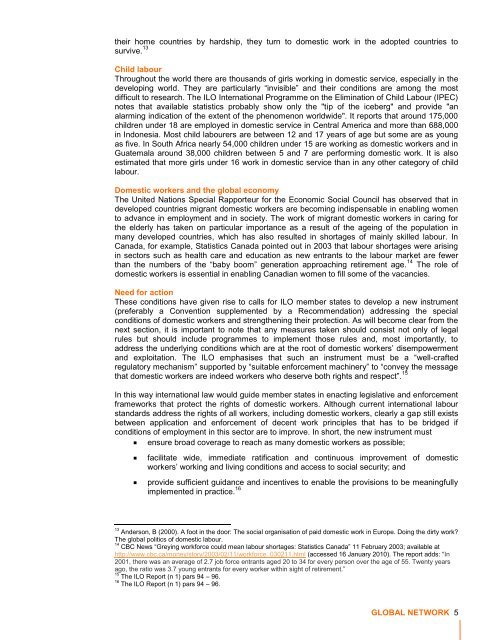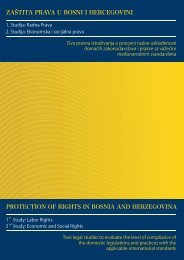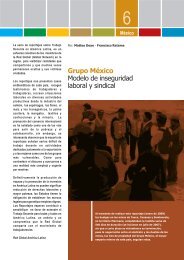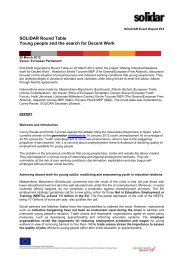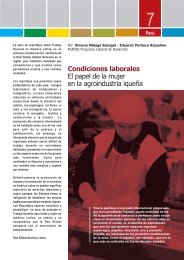domestic workers: decent work for all â south africa - Solidar
domestic workers: decent work for all â south africa - Solidar
domestic workers: decent work for all â south africa - Solidar
Create successful ePaper yourself
Turn your PDF publications into a flip-book with our unique Google optimized e-Paper software.
their home countries by hardship, they turn to <strong>domestic</strong> <strong>work</strong> in the adopted countries to<br />
survive. 13<br />
Child labour<br />
Throughout the world there are thousands of girls <strong>work</strong>ing in <strong>domestic</strong> service, especi<strong>all</strong>y in the<br />
developing world. They are particularly ―invisible‖ and their conditions are among the most<br />
difficult to research. The ILO International Programme on the Elimination of Child Labour (IPEC)<br />
notes that available statistics probably show only the "tip of the iceberg" and provide "an<br />
alarming indication of the extent of the phenomenon worldwide". It reports that around 175,000<br />
children under 18 are employed in <strong>domestic</strong> service in Central America and more than 688,000<br />
in Indonesia. Most child labourers are between 12 and 17 years of age but some are as young<br />
as five. In South Africa nearly 54,000 children under 15 are <strong>work</strong>ing as <strong>domestic</strong> <strong><strong>work</strong>ers</strong> and in<br />
Guatemala around 38,000 children between 5 and 7 are per<strong>for</strong>ming <strong>domestic</strong> <strong>work</strong>. It is also<br />
estimated that more girls under 16 <strong>work</strong> in <strong>domestic</strong> service than in any other category of child<br />
labour.<br />
Domestic <strong><strong>work</strong>ers</strong> and the global economy<br />
The United Nations Special Rapporteur <strong>for</strong> the Economic Social Council has observed that in<br />
developed countries migrant <strong>domestic</strong> <strong><strong>work</strong>ers</strong> are becoming indispensable in enabling women<br />
to advance in employment and in society. The <strong>work</strong> of migrant <strong>domestic</strong> <strong><strong>work</strong>ers</strong> in caring <strong>for</strong><br />
the elderly has taken on particular importance as a result of the ageing of the population in<br />
many developed countries, which has also resulted in shortages of mainly skilled labour. In<br />
Canada, <strong>for</strong> example, Statistics Canada pointed out in 2003 that labour shortages were arising<br />
in sectors such as health care and education as new entrants to the labour market are fewer<br />
than the numbers of the ―baby boom‖ generation approaching retirement age. 14 The role of<br />
<strong>domestic</strong> <strong><strong>work</strong>ers</strong> is essential in enabling Canadian women to fill some of the vacancies.<br />
Need <strong>for</strong> action<br />
These conditions have given rise to c<strong>all</strong>s <strong>for</strong> ILO member states to develop a new instrument<br />
(preferably a Convention supplemented by a Recommendation) addressing the special<br />
conditions of <strong>domestic</strong> <strong><strong>work</strong>ers</strong> and strengthening their protection. As will become clear from the<br />
next section, it is important to note that any measures taken should consist not only of legal<br />
rules but should include programmes to implement those rules and, most importantly, to<br />
address the underlying conditions which are at the root of <strong>domestic</strong> <strong><strong>work</strong>ers</strong>’ disempowerment<br />
and exploitation. The ILO emphasises that such an instrument must be a ―well-crafted<br />
regulatory mechanism‖ supported by ―suitable en<strong>for</strong>cement machinery‖ to ―convey the message<br />
that <strong>domestic</strong> <strong><strong>work</strong>ers</strong> are indeed <strong><strong>work</strong>ers</strong> who deserve both rights and respect‖. 15<br />
In this way international law would guide member states in enacting legislative and en<strong>for</strong>cement<br />
frame<strong>work</strong>s that protect the rights of <strong>domestic</strong> <strong><strong>work</strong>ers</strong>. Although current international labour<br />
standards address the rights of <strong>all</strong> <strong><strong>work</strong>ers</strong>, including <strong>domestic</strong> <strong><strong>work</strong>ers</strong>, clearly a gap still exists<br />
between application and en<strong>for</strong>cement of <strong>decent</strong> <strong>work</strong> principles that has to be bridged if<br />
conditions of employment in this sector are to improve. In short, the new instrument must<br />
• ensure broad coverage to reach as many <strong>domestic</strong> <strong><strong>work</strong>ers</strong> as possible;<br />
• facilitate wide, immediate ratification and continuous improvement of <strong>domestic</strong><br />
<strong><strong>work</strong>ers</strong>’ <strong>work</strong>ing and living conditions and access to social security; and<br />
• provide sufficient guidance and incentives to enable the provisions to be meaningfully<br />
implemented in practice. 16<br />
13 Anderson, B (2000). A foot in the door: The social organisation of paid <strong>domestic</strong> <strong>work</strong> in Europe. Doing the dirty <strong>work</strong>?<br />
The global politics of <strong>domestic</strong> labour.<br />
14 CBC News ―Greying <strong>work</strong><strong>for</strong>ce could mean labour shortages: Statistics Canada‖ 11 February 2003; available at<br />
http://www.cbc.ca/money/story/2003/02/11/<strong>work</strong><strong>for</strong>ce_030211.html (accessed 16 January 2010). The report adds: ―In<br />
2001, there was an average of 2.7 job <strong>for</strong>ce entrants aged 20 to 34 <strong>for</strong> every person over the age of 55. Twenty years<br />
ago, the ratio was 3.7 young entrants <strong>for</strong> every <strong>work</strong>er within sight of retirement.‖<br />
15 The ILO Report (n 1) pars 94 – 96.<br />
16 The ILO Report (n 1) pars 94 – 96.<br />
GLOBAL NETWORK 5


